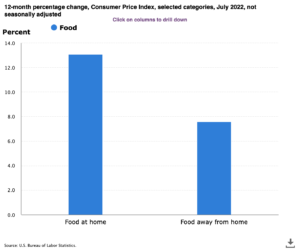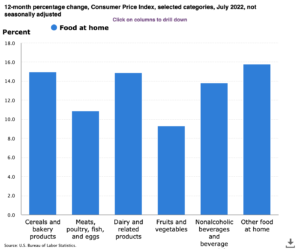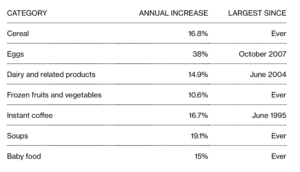Beef prices are projected to continue increasing as U.S. beef production declines with no signs of a cattle herd rebuild. Additionally, cheap beef may soon become further out of reach…
U.S. Food Prices Climb Most Since 1979
Don Lee reported on the front page of today’s Los Angeles Times that, “After months of steadily climbing to a 40-year high, the pace of inflation slowed notably in July as gas prices fell sharply and Americans got relief on the cost of clothing, used cars and some other necessities.
“The price index for all consumer goods and services was unchanged over the month. And the annual rate of inflation in July edged down to 8.5% from 9.1% in June, according to the Bureau of Labor Statistics in a report issued Wednesday.
“The June inflation figure, the highest since November 1981, is now looking like it may have been the peak of the price surge that began in spring 2021.”
Mr. Lee noted that, “The war in Ukraine continues to put pressure on global grain supplies and prices, and an outbreak of avian flu has hit poultry products and eggs.”
Inflation dropped to 8.5% in July (down from 9.1% in June).
— Heather Long (@byHeatherLong) August 10, 2022
Big declines in gas prices (-7.7% in July) and airfares (-7.8% in July) helped a lot.
But...grocery prices, rent and electricity continue to rise pic.twitter.com/sVO5dr6eco
And yesterday, Bloomberg writer Molly Smith reported that, “Food prices in the US soared in July, keeping the cost of living painfully high even as lower gasoline costs offered some relief to consumers.

The Bloomberg article indicated that,
Overall food prices climbed 10.9% from a year earlier, the biggest increase since 1979, according to data published by the Labor Department on Wednesday.
“Several essentials like cereal and certain dairy products posted record year-over-year rises.”

Smith explained that, “On a month-over-month basis, food prices rose 1.14%, the most since April 2020. The cost of food away from home, like restaurant meals, also continued to advance, though at a slower pace than groceries.”

Rachel Siegel reported on the front page of today’s Washington Post that, “Grocery and housing costs continue to strain peoples’ budgets — and will also need to see months of steady declines for overall inflation to near more normal l. evels.The food index continued to creep up, rising 1.1 percent over the month. Bread was up 2.8 percent over the month, and chicken 1.4 percent. Canned vegetables were up 1.5 percent.”
Also yesterday, Bloomberg writer Martine Paris reported that, “Inflation is wreaking havoc on breakfast, with egg prices at grocery stores soaring a whopping 47% in July over last year, according to retail analytics firm Information Resources Inc.
“Although the Consumer Price Index came in lower than expected at 8.5% in July, inflation is continuing to hit grocery shopping.”
The Bloomberg article pointed out that, “Egg prices in particular have been driven higher by one of the worst bird flu outbreaks in US history, killing more than 30 million commercial and wild birds. The crisis hurt egg-laying hens and turkeys the most. Although the outbreak has eased in the US, growers are still repopulating their flocks, which is expected to bring prices down eventually.”





